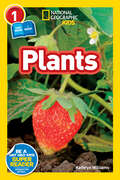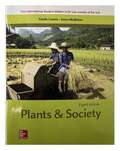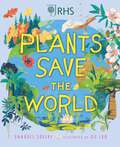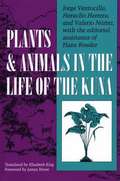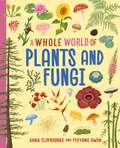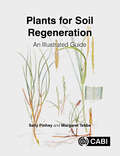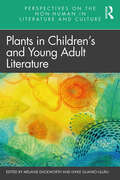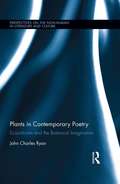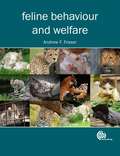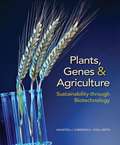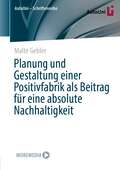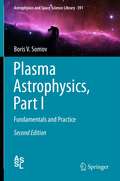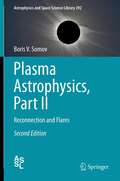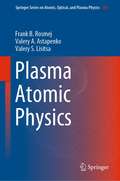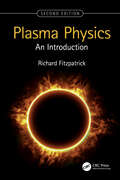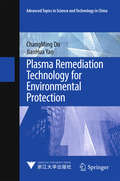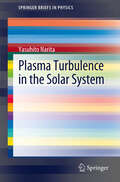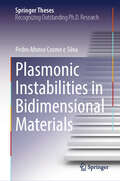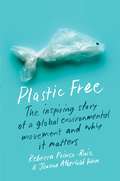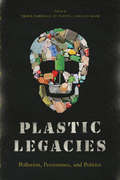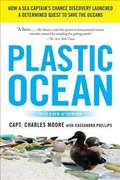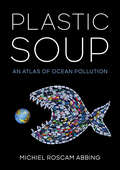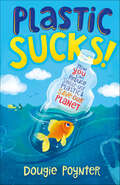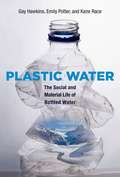- Table View
- List View
Plants (Readers)
by Kathryn WilliamsAdult and child readers will learn all about plants together in this new Co-reader from National Geographic Kids. Find out how plants grow as well as the different parts of plants, seeds, and flowers.
Plants And Society
by Estelle Levetin Karen McMahonThis introductory, one quarter/one-semester text takes a multidisciplinary approach to studying the relationship between plants and people. The authors strive to stimulate interest in plant science and encourage students to further their studies in botany. Also, by exposing students to society's historical connection to plants, Levetin and McMahon hope to instill a greater appreciation for the botanical world. Plants and Society covers basic principles of botany with strong emphasis on the economic aspects and social implications of plants and fungi.
Plants Save the World
by Annabel SaveryProduced in partnership with the RHS, Plants Save the World shows how plants are going to help us to SAVE the world!From tiny seeds and weeds to massive trees, plants come in all different shapes, sizes and colours. They can be found all over the world. In fact, they're so common, we hardly notice them at all. But plants are the foundation of all life on Earth - without them, we cannot survive! They provide food and medicine, clean the air we breathe, provide habitats for animals, protect against disasters, such as flooding, and are used to make products that we use every day. But plants are threatened by humans and so this book shows you how you can help to save them, too!Supports the science curriculum in the study of plant life cycles, plant parts, food chains, ecosystems, deforestation and habitats.In the accompanying book, Bugs Save the World, you can discover why bugs are so important to the survival of our planet, too.
Plants and Animals in the Life of the Kuna
by Jorge Ventocilla Heraclio Herrera Valerio Núñez"The earth is the mother of all things"; thus begins this original and accessible book on how the Kuna of Panama relate to the natural world. An integrative project involving Kuna traditional leaders and trained scholars, and fully illustrated by a Kuna artist, this translation of Plantas y animales en la vida del pueblo Kuna focuses on Kuna plant and animal life, social life, and social change as a means of saving traditional ecological knowledge and "returning" it to the community. The authors hope to preserve the Kuna environment not only by reviving traditional technologies but also by educating the Kuna as to what needs protection. While the Kuna have a tradition of living in harmony with the land, the intrusion of the market economy is eroding the very basis of their sustainable way of life. As a response to this crisis, this book seeks to develop native self-awareness and provide a model for collaboration. It will appeal to Latin Americanists, anthropologists, and ethnobotanists, as well as to a general readership in environmental issues.
Plants and Fungi (A Whole World of... #5)
by Anna ClaybourneGet lost in the diverse and beautiful world of plants and fungi - with more to explore than you ever imagined!A Whole World of Plants and Fungi presents the stunning breadth of plant and fungus varieties that fill the Earth. What is the difference between a plant and a fungus? What exactly is the purpose of a pine cone? Which plants can survive in the driest deserts, and which prefer the hot, humid tropics? This book has the answers and so many more facts filling the beautifully illustrated pages.A Whole World of is a book series looking at the extraordinary diversity of life on Earth - the defining features and evolutionary branches - and encourages readers age 7 and up to consider why it is important to maintain biodiversity. Written by award-winning author, Anna Claybourne, with artwork by award-winning illustrator, Yekyung Kwon.Books in the series:A Whole World of Mammals/A Whole World of Prehistoric Life/A Whole World of Minibeasts/A Whole World of Birds/A Whole World of Rocks and Minerals/A Whole World of Plants and Fungi
Plants for Soil Regeneration: An Illustrated Guide
by Sally Pinhey Margaret TebbsThis book is a comprehensive, beautifully illustrated colour guide to the plants which farmers, growers and gardeners can use to improve soil structure and restore fertility without the use and expense of agrichemicals. Information based on the latest research is given on how to use soil conditioning plants to avoid soil degradation, restore soil quality and help clean polluted land. There are 11 chapters: 1 to 6 cover soil health, nitrogen fixation, green manures and herbal leys, bacteria and other microorganisms, phytoremediators and soil mycorrhiza (plant-fungal symbiosis). Chapter 7 has plant illustrations, with climate range and soil types, along with their soil conditioning properties and each plant is presented with a comprehensive description opposite a detailed illustration, in full colour. Chapters 8 to 10 examine soil stabilisers, weeds and invasive plants, and hedges and trees and the final chapter, contains 5 case studies with the most recent data, followed by an appendix and glossary. The book allows the reader to identify the plants they need quickly and find the information necessary to begin implementation of soil regeneration.
Plants in Children’s and Young Adult Literature (Perspectives on the Non-Human in Literature and Culture)
by Melanie DuckworthFrom the forests of the tales of the Brothers Grimm to Enid Blyton’s The Faraway Tree, from the flowers of Cicely May Barker’s fairies to the treehouse in Andy Griffith and Terry Denton’s popular 13-Storey Treehouse series, trees and other plants have been enduring features of stories for children and young adults. Plants act as gateways to other worlds, as liminal spaces, as markers of permanence and change, and as metonyms of childhood and adolescence. This anthology is the first compilation devoted entirely to analysis of the representation of plants in children’s and young adult literatures, reflecting the recent surge of interest in cultural plant studies within the environmental humanities. Mapping out and presenting an internationally inclusive view of plant representation in texts for children and young adults, the volume includes contributions examining European, American, Australian, and Asian literatures and contributes to the research fields of ecocriticism, critical plant studies, and the study of children’s and young adult literatures.
Plants in Contemporary Poetry: Ecocriticism and the Botanical Imagination (Perspectives on the Non-Human in Literature and Culture)
by John RyanPositioned within current ecocritical scholarship, this volume is the first book-length study of the representations of plants in contemporary American, English, and Australian poetry. Through readings of botanically-minded writers including Les Murray, Louise Glück, and Alice Oswald, it addresses the relationship between language and the subjectivity, agency, sentience, consciousness, and intelligence of vegetal life. Scientific, philosophical, and literary frameworks enable the author to develop an interdisciplinary approach to examining the role of plants in poetry. Drawing from recent plant science and contributing to the exciting new field of critical plant studies, the author develops a methodology he calls "botanical criticism" that aims to redress the lack of emphasis on plant life in studies of poetry. As a subset of ecocriticism, botanical criticism investigates how poets engage with plants literally and figuratively, materially and symbolically, in their works. Key themes covered in this volume include plants as invasives and weeds in human settings; as sources of physical and spiritual nourishment; as signifiers of region, home, and identity; as objects of aesthetics and objectivism; and, crucially, as beings with their own perspectives, voices, and modes of dialogue. Ryan demonstrates that poetic imagination is as essential as scientific rationality to elucidating and appreciating the mysteries of plant-being. This book will appeal to a multidisciplinary readership in the fields of ecocriticism, ecopoetry, environmental humanities, and ecocultural studies, and will be of interest to researchers in the emerging area of critical plant studies.
Plants, Biotechnology and Agriculture
by Denis MurphyAt a time when the world's food supplies are increasingly unable to meet the needs of a burgeoning population, the subject matter of this book has never been more relevant. At the same time, there is significant diversity of opinion concerning the benefits and perceived dangers of the applications of biotechnology in food production. To help inform this debate, the aim of Plants, Biotechnology & Agriculture is to provide the reader with a comprehensive yet concise overview of plants as both biological organisms and useful resources for people to exploit. The first half of the book gives a basic overview of plant biology including how plants develop and respond to their environment, acting as a primer for those without a biology background and a refresher for students of plant biology and agriculture. These chapters set the scene for an outline of human exploitation of plants, from domestication to scientific manipulation. The complex technologies now being applied to improving crops are then described, guiding the reader through the extensive terminologies and jargon, using focus boxes to illustrate key processes and issues. The final two chapters address society's response to biotechnology, how these technologies are being modified in response to public concerns, and new technologies being developed to meet the challenges of rapid population growth, depletion of non-renewable resources and climate change.
Plants, Genes, and Agriculture: Plants, Genes, and Agriculture
by Paul Gepts Maarten Chrispeels<p>What needs to happen if we are going to feed almost 10 billion people by the year 2050 in a sustainable way? Written for first- and second-year university students, this interdisciplinary textbook addresses this challenging question, presenting biological, economic, and sociocultural issues at an introductory level. <p>Presenting and integrating information from many disciplines, this book invites readers to consider the complexity of feeding humanity and increasing food production sustainably. <p>Topics covered include: <p> <li>the development, physiology, and nutrition of plants <li>human nutrition and food safety <li>photosynthesis and energy transformations <li>genetics, molecular biology, and genomics, including the techniques of genetic transformation (gene silencing, gene editing with CRISPR) used in modern crop breeding <li>crop domestication and plant breeding <li>soil ecosystems <li>the biotic (animal pests, diseases, and weeds) and abiotic (drought, flooding, temperature extremes, and soil degradation) stresses that limit crop production <li>technological advances and how new innovations (equipment, chemical products, and improved plant varieties) reach farmers and eventually affect what we eat; also discusses legal aspects (e.g., patents) relevant to agricultural innovations <li>plants as sources of pharmaceuticals and specialty chemicals</li> <p> <p>Although publicized in the controversies surrounding "genetically modified organisms" (GMOs), the applications of modern biotechnology to agriculture extend far beyond GMOs, and include crop improvements that rely on knowledge of the plant's genomes and its analysis by bioinformatics. This unifying theme of the text is stressed in coverage of a number of issues that appear throughout the chapters, including: <p> <li>how crop plant breeders look for specific traits to solve practical problems <li>genetic engineering of crops as a useful way to supplement conventional plant breeding <li>the nature of agribusiness in industrialized countries <li>the vital contributions of developing countries and their smallhold farmers, and the unique challenges facing them </li> <p> <p>Challenging and controversial topics such as the safety of pesticides and GMOs, the increasing demand for animal products and the stresses this puts on agricultural output, organic farming and foods, and patenting new crop varieties are dealt with in a balanced way, inviting teachers and students to consider all the implications of these serious questions.</p>
Planung und Gestaltung einer Positivfabrik als Beitrag für eine absolute Nachhaltigkeit (AutoUni – Schriftenreihe #162)
by Malte GeblerDas Konzept einer „Positivfabrik“ beschreibt die Vision, dass Fabriken und ihre Wertschöpfungsprozesse eine nachhaltige Entwicklung in der Biosphäre und in menschlichen Gesellschaften fördern. Positive Fabriken agieren daher als Impulsgeber für nachhaltige Lebensräume, indem sie Ökosysteme schützen, soziale Angebote bereitstellen und eine gemeinwohlorientierte wirtschaftliche Entwicklung unterstützen. Die Planung und Gestaltung einer Positivfabrik erfordert eine methodische und prozessuale Systematik, die der Autor strukturiert herleitet. Die inhaltliche Beschreibung des Prototyps einer Positivfabrik und die Konzeptanwendung verdeutlichen, wie eine Positivfabrik in der Praxis realisiert werden kann.
Plasma Astrophysics, Part I: Fundamentals and Practice
by Boris V. SomovThis two-part book is devoted to classic fundamentals and current practices and perspectives of modern plasma astrophysics. This first part uniquely covers all the basic principles and practical tools required for understanding and work in plasma astrophysics. More than 25% of the text is updated from the first edition, including new figures, equations and entire sections on topics such as magnetic reconnection and the Grad-Shafranov equation. <P><P> The book is aimed at professional researchers in astrophysics, but it will also be useful to graduate students in space sciences, geophysics, applied physics and mathematics, especially those seeking a unified view of plasma physics and fluid mechanics.
Plasma Astrophysics, Part II: Reconnection and Flares
by Boris V. SomovThis two-part book is devoted to classic fundamentals and current practices and perspectives of modern plasma astrophysics. This second part discusses the physics of magnetic reconnection and flares of electromagnetic origin in space plasmas in the solar system, single and double stars, relativistic objects, accretion disks and their coronae. More than 25% of the text is updated from the first edition, included the additions of new figures, equations and entire sections on topics such as topological triggers for solar flares and the magnetospheric physics problem. This book is aimed at professional researchers in astrophysics, but it will also be useful to graduate students in space sciences, geophysics, applied physics and mathematics, especially those seeking a unified view of plasma physics and fluid mechanics.
Plasma Atomic Physics (Springer Series on Atomic, Optical, and Plasma Physics #104)
by Frank B. Rosmej Valery A. Astapenko Valery S. LisitsaPlasma Atomic Physics provides an overview of the elementary processes within atoms and ions in plasmas, and introduces readers to the language of atomic spectra and light emission, allowing them to explore the various and fascinating radiative properties of matter. The book familiarizes readers with the complex quantum-mechanical descriptions of electromagnetic and collisional processes, while also developing a number of effective qualitative models that will allow them to obtain adequately comprehensive descriptions of collisional-radiative processes in dense plasmas, dielectronic satellite emissions and autoionizing states, hollow ion X-ray emissions, polarized atoms and ions, hot electrons, charge exchange, atomic population kinetics, and radiation transport. Numerous applications to plasma spectroscopy and experimental data are presented, which concern magnetic confinement fusion, inertial fusion, laser-produced plasmas, and X-ray free-electron lasers’ interaction with matter. Particular highlights include the development of quantum kinetics to a level surpassing the almost exclusively used quasi-classical approach in atomic population kinetics, the introduction of the recently developed Quantum-F-Matrix-Theory (QFMT) to study the impact of plasma microfields on atomic populations, and the Enrico Fermi equivalent photon method to develop the “Plasma Atom”, where the response properties and oscillator strength distribution are represented with the help of a local plasma frequency of the atomic electron density.Based on courses held by the authors, this material will assist students and scientists studying the complex processes within atoms and ions in different kinds of plasmas by developing relatively simple but highly effective models. Considerable attention is paid to a number of qualitative models that deliver physical transparency, while extensive tables and formulas promote the practical and useful application of complex theories and provide effective tools for non-specialist readers.
Plasma Physics: An Introduction
by Richard FitzpatrickEncompasses the Lectured Works of a Renowned Expert in the Field Plasma Physics: An Introduction is based on a series of university course lectures by a leading name in the field, and thoroughly covers the physics of the fourth state of matter. This textbook provides a concise and cohesive introduction to plasma physics theory and offers a solid foundation for students of physics wishing to take higher level courses in plasma physics. Mathematically Rigorous, but Driven by Physics The author provides an in-depth discussion of the various fluid theories typically used in plasma physics, presenting non-relativistic, fully ionized, nondegenerate, quasi-neutral, and weakly coupled plasma. This second edition has been fully updated to include new content on collisions and magnetic reconnection. It contains over 80 exercises—carefully selected for their pedagogical value—with fully worked out solutions available in a separate solutions manual for professors. The material presents a number of applications, and works through specific topics including basic plasma parameters, the theory of charged particle motion in inhomogeneous electromagnetic fields, collisions, plasma fluid theory, electromagnetic waves in cold plasmas, electromagnetic wave propagation through inhomogeneous plasmas, kinetic theory, magnetohydrodynamical fluid theory, and magnetic reconnection.
Plasma Remediation Technology for Environmental Protection
by Changming Du Jianhua YanThis book introduces a new technology for environmental protection, namely plasma cleaning. It brings together technological advances and research on plasma generators and their application in environmental science and engineering, including contaminated soil remediation, waste water degradation, metal recovery from waste solution, sterilization and polluted air remediation. It provides a balanced and comprehensive discussion of the core principles, novel plasma reactors and diagnostics, and state-of-the-art environmental applications of plasma. As such, it represents a valuable reference guide for scientists, engineers and graduate students in the fields of environmental science and plasma physics.
Plasma Turbulence in the Solar System
by Yasuhito NaritaDynamics of astrophysical systems is often described by plasma physics, yet understanding the nature of plasma turbulence remains as a challenge in physics in both theories and experiments. This book is an up-to-date summary and review of recent results in research on waves and turbulence in near-Earth space plasma turbulence, obtained by Cluster, the multi-spacecraft mission. Spatial and temporal structures of solar wind turbulence as well as its interaction with the bow shock ahead of the Earth are presented using Cluster data. The book presents (1) historical developments, (2) theoretical background of plasma physics, turbulence theories, and the plasma physical picture of the solar system, (3) analysis methods for multi-spacecraft data, (4) results of Cluster data analysis, and (5) impacts on astrophysics and Earth sciences.
Plasmonic Instabilities in Bidimensional Materials (Springer Theses)
by Pedro Afonso Cosme e SilvaThis book provides an in-depth analysis of the hydrodynamics of two-dimensional (2D) electronic systems, with a particular focus on graphene and other Dirac materials. It explores the theoretical framework and numerical simulations to uncover the potential of plasmonic instabilities in advancing nanotechnology. Moreover, the book also addresses the collective behaviour of quasiparticles in 2D materials and offers insights into the complex interplay between hydrodynamic behaviours and plasmonic phenomena. The main topics covered in this book include the hydrodynamic description of charge carriers, nonlinear waves, and topological effects in 2D electronic systems. It provides a comprehensive treatment of the Boltzmann equation to derive fluid-like transport equations, which are then used to study the collective responses and behaviours of these systems. The book also relies on the concept of electrostatic excitations, the plasmons, as an additional fluid and explores their effects and interplay with the charge carriers. One of the significant contributions of this book is the investigation of plasmonic instabilities and their potential applications in creating new active nanodevices, such as THz radiation sources. The theoretical findings are supported by extensive numerical simulations, providing a deeper understanding of the principles governing electronic flow in 2D materials. Further, this work also examines the nonlinear dynamics of electrohydrodynamics, revealing phenomena such as solitary waves, and the criteria for their occurrence. Lastly, the novel aspects of topological efects on the charge flow are also investigated. The importance of this work lies in its dual contribution to fundamental research and practical applications. On the theoretical side, it advances our understanding of the hydrodynamic regime of 2D materials and the transient and dynamic responses of these systems. On the practical side, it proposes novel device implementations, such as plasmonics oscillators and waveguides. On that topic, the book addresses the challenges of these devices, offering solutions to enhance controllability and to boost performance as well. This book is essential for graduate students, researchers, and professionals in the fields of quantum plasmas, 2D materials, and plasmonics. It is particularly valuable for plasma scientists interested in exploring 2D materials and condensed matter physicists who wish to study the hydrodynamic regime and the dynamic responses of these systems. By providing a detailed and comprehensive understanding of these advanced topics, this book paves the way for future research and technological innovations in the rapidly evolving fields of electrohydrodynamics and plasmonics.
Plastic Free: The Inspiring Story of a Global Environmental Movement and Why It Matters
by Joanna Atherfold Finn Rebecca Prince-RuizIn July 2011, Rebecca Prince-Ruiz challenged herself to go plastic free for the whole month. Starting with a small group of people in the city of Perth, the Plastic Free July movement has grown into a 250-million strong community across 177 countries, empowering people to reduce single-use plastic consumption and create a cleaner future.This book explores how one of the world’s leading environmental campaigns took off and shares lessons from its success. From narrating marine-debris research expeditions to tracking what actually happens to our waste to sharing insights from behavioral research, it speaks to the massive scale of the plastic waste problem and how we can tackle it together. Interweaving interviews from participants, activists, and experts, Plastic Free tells the inspiring story of how ordinary people have created change in their homes, communities, workplaces, schools, businesses, and beyond.It is easy to feel overwhelmed in the face of global environmental problems and wonder what difference our own actions could possibly make. Plastic Free offers hope for the future through the stories of those who have taken on what looked like an insurmountable challenge and succeeded in innovative and practical ways, one step—and one piece of plastic—at a time.
Plastic Legacies: Pollution, Persistence, and Politics
by Ian Shaw Sy Taffel Trisia FarrellyThere is virtually nowhere on earth that remains untouched by plastics and the situation presents a serious threat to our natural world. Despite the magnitude of the problem, the interventions most often put in place are consumer-led and market-based and only nominally capable of addressing the issue. As the problem worsens and neoliberal ideologies limit the world’s responses to this crisis, there is a growing need for legislative frameworks that attend to the complex social and ecological issues associated with plastics. The contributors to this volume bring expertise from across academic disciplines to illustrate how plastics are produced, consumed, and discarded and to find holistic and integrated approaches that demonstrate an understanding of the wide-ranging problem. From the plasticization of earth’s oceans to the endocrine disrupting chemicals that have the potential to seriously harm life as we know it, these essays beg the question that we all must answer: what is our plastic legacy? With contributions by: Imogen E. Napper, Sabine Pahl, Richard C. Thompson, Sasha Adkins, Stephanie B. Borrelle, Jennifer Provencher, Tina Ngata, Sven Bergmann, Christina Gerhardt, Elyse Stanes, Tridibesh Dey, Mike Michael, Laura McLauchlan, Johanne Tarpgaard, Deirdre McKay, Padmapani Perez, Lei Xiaoyu, and John Holland.
Plastic Ocean
by Capt. Charles MooreA prominent seafaring environmentalist and researcher shares his shocking discovery of the Great Pacific Garbage Patch, and inspires a fundamental rethinking of the Plastic Age. In the summer of 1997, Charles Moore set sail from Honolulu returning home after competing in a trans-Pacific race. To get to California, he and his crew took a shortcut through the seldom-traversed North Pacific Subtropical Gyre, a vast "oceanic desert" where winds are slack and sailing ships languish. There, Moore realized his catamaran was surrounded by a "plastic soup." He had stumbled upon the largest garbage dump on the planet--a spiral nebula where plastic outweighed zooplankton, the ocean's food base, by a factor of six to one. In Plastic Ocean, Moore recounts his ominous findings and unveils the secret life and hidden proper ties of plastics. From milk jugs to polymer molecules small enough to penetrate human skin or be unknowingly inhaled, plastic is now suspected of contributing to a host of ailments, including infertility, autism, thyroid dysfunction, and some cancers. An urgent call to action, Moore's sobering revelations will be embraced by activists, concerned parents, and anyone concerned about the deadly impact and implications of this man-made blight.
Plastic Planet: How Plastic Came to Rule the World (and What You Can Do to Change It)
by Georgia Amson-BradshawPlastic Planet offers young readers the perfect, non-alarmist introduction to Earth's plastic crisisPlastic pollution is now found in every environment on Earth, from the deepest oceans to the driest deserts and the most remote ice sheets.Plastic Planet offers readers aged 8 and up a look at plastic through the ages, exploring what it is, how it's made and how we have become so dependent on it in a single-use, disposable world. It highlights the social inequality of plastic pollution and explores how plastic has become a widespread and dangerous pollutant that is inextricably linked to climate change. The book looks ahead to possible solutions to our plastic crisis, from global changes such as changing people's mindsets, to innovations such as compostable plastics, to practical solutions such as recycling and bottle return schemes.
Plastic Soup: An Atlas of Ocean Pollution
by Michiel Roscam AbbingPlastics have transformed every aspect of our lives. Yet the very properties that make them attractive—they are cheap to make, light, and durable—spell disaster when trash makes its way into the environment. Plastic Soup: An Atlas of Ocean Pollution is a beautifully-illustrated survey of the plastics clogging our seas, their impacts on wildlife and people around the world, and inspirational initiatives designed to tackle the problem. In Plastic Soup, Michiel Roscam Abbing of the Plastic Soup Foundation reveals the scope of the issue: plastic trash now lurks on every corner of the planet. With striking photography and graphics, Plastic Soup brings this challenge to brilliant life for readers. Yet it also sends a message of hope; although the scale of the problem is massive, so is the dedication of activists working to check it. Plastic Soup highlights a diverse array of projects to curb plastic waste and raise awareness, from plastic-free grocery stores to innovative laws and art installations. According to some estimates, if we continue on our current path, the oceans will contain more plastic than fish by the year 2050. Created to inform and inspire readers, Plastic Soup is a critical tool in the fight to reverse this trend.
Plastic Sucks!: How You Can Reduce Single-Use Plastic & Save Our Planet
by Dougie PoynterHow can YOU help save our planet? This awesome and inspiring guide, written by musician and environmental activist Dougie Poynter, will tell you how to get involved in the mission to cut out single-use plastic.Plastic is everywhere and it sucks. It fills up our oceans, endangers our wildlife and never goes away. So it's time to take action, find ways to cut down our plastic use, and help protect our environment. Together we can make a difference!From the history of plastic to the effects of plastic on our planet to the innovations in plastic clean up and alternative materials, this book breaks down the plastic problem into easy digestible chapters (including "What's Going On", "Innovations in Cleanup," and "How to Create Change") that are packed with illustrations. And this isn't just a history of what's gone wrong with our environment; it's a handbook on how to change the world for better, empowering you to make everyday choices that help solve the plastic problem once and for all. Plastic Sucks! How YOU Can Reduce Single-Use Plastic and Save Our Planet shows us how we can all make small changes and become champions for our planet.
Plastic Water
by Kane Race Emily Potter Gay HawkinsHow did branded bottles of water insinuate themselves into our daily lives? Why did water become an economic good -- no longer a common resource but a commercial product, in industry parlance a "fast moving consumer good," or FMCG? Plastic Water examines the processes behind this transformation. It goes beyond the usual political and environmental critiques of bottled water to investigate its multiplicity, examining a bottle of water's simultaneous existence as, among other things, a product, personal health resource, object of boycotts, and part of accumulating waste matter. Throughout, the book focuses on the ontological dimensions of drinking bottled water -- the ways in which this habit enacts new relations and meanings that may interfere with other drinking water practices.The book considers the assemblage and emergence of a mass market for water, from the invention of the polyethylene terephthalate (PET) bottle in 1973 to the development of "hydration science" that accompanied the rise of jogging in the United States. It looks at what bottles do in the world, tracing drinking and disposal practices in three Asian cities with unreliable access to safe water: Bangkok, Chennai, and Hanoi. And it considers the possibility of ethical drinking, examining campaigns to "say no" to the bottle and promote the consumption of tap water in Canada, the United States, and Australia.
